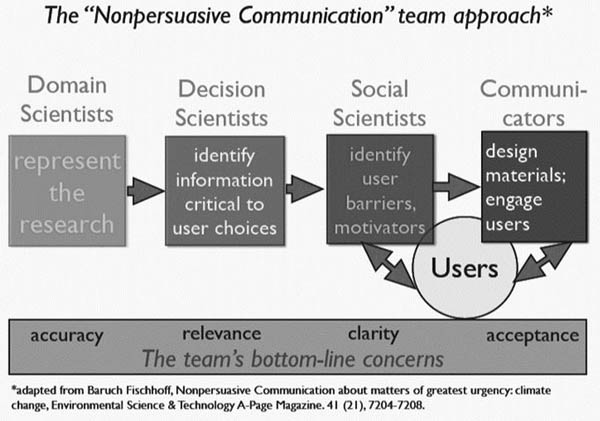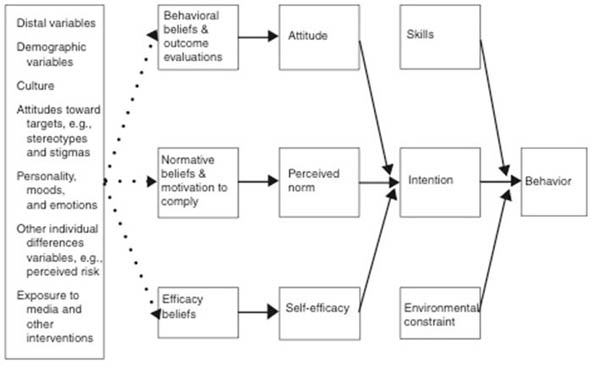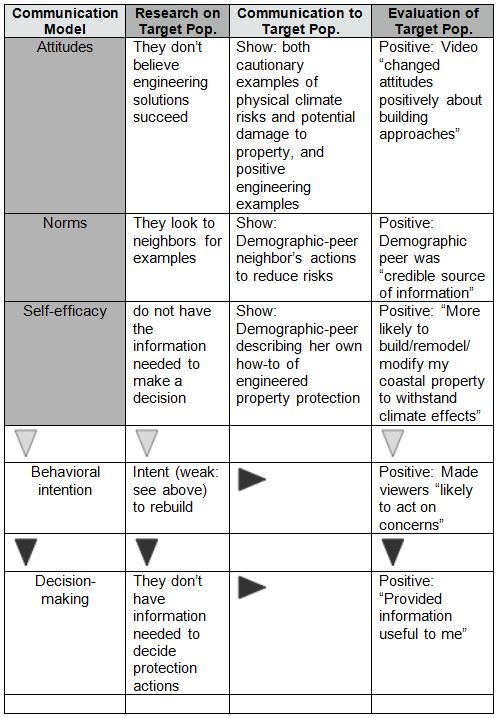 |
April 2013
|
April 2013 // Volume 51 // Number 2 // Ideas at Work // v51-2iw2
Creating Research-Based Videos That Can Affect Behavior
Abstract
To engage recipients of Extension science-based video programming involves understanding what behaviors and decisions the recipients may be considering that can be affected by the programming. Such understanding may be developed through interviews, focus groups, and surveys, which should provide guidance for elements of the style and content of the video production. The success of the video in assisting viewers' decision-making should then be evaluated, for example through a survey, as described here. The approach presented draws upon and twines models from two different strands of communication research: nonpersuasive communication (Fischoff, 2007) and behavioral prediction (Fishbein & Yzer, 2003).
Introduction
With so many broadcast and online channels to watch—consider YouTube alone—viewers today have a wide range of video information available to them. Traditionally, Extension and other university communicators have occupied the niche of delivering scientific, research-based (and thus, presumptively credible) information via "educational" videos. But just as the overall Extension paradigm has shifted from primarily information delivery to engagement with users (Kellogg Commission, 2001), so also is a shift appropriate for Extension video.
Shifting paradigms is never easily accomplished (Kuhn, 1996), and for professional communicators, one challenge of working in academia—a beehive of specialized knowledge-holders—is that the accurate transmission of that specialized knowledge often drives communication activities. But an exclusive emphasis on content-accuracy risks weakening communication by giving priority to what's important to us rather than to what's important to the viewers (Olson, 2009). Budgets and time don't always permit, but in our Sea Grant Extension productions, we like to first conduct empirical research with the target populations to understand the decisions they are trying to make on a topical issue.
Our working hypothesis is that if we provide information that helps and supports viewers in understanding concerns that are important to them, they would value such information and be moved toward informed action. The hypothesis is perhaps a bit more subtle than it sounds at first. In fact, it draws upon and twines models from two different strands of communication research: nonpersuasive communication (Fischoff, 2007) and behavioral prediction (Fishbein & Yzer, 2003).
The nonpersuasive communication model (Figure 1) derives from decision research and emphasizes understanding how the target population views potential concerns, so that communication can be targeted to aid their understanding and decision-making. The behavioral prediction model (Figure 2) informs communication by calling attention first to the variables that influence behavioral intention—attitudes, social norms, and sense of self-efficacy. Thus, any given behavior is more likely to occur if you have a positive view of the behavior, if the views of people whom you consider important support the behavior, and if you think you can perform the proposed behavior. With a positive behavioral intention, plus the needed skills and lack of constraints in the environment, this model says the behavior will be performed. Accordingly, communication needs to address such variables.
Figure 1.
The Nonpersuasive Communication Model (adapted with permission from Fischhoff, 2007)

Figure 2.
The Integrative Model of Behavioral Prediction (Fishbein & Yzer, 2003, p. 167)

Empirical Research Describes Target Populations
Two video programs we recently developed with Extension colleagues in Maine and Oregon show our approach based on these models. Both videos (Cone, 2009; Cone, 2010) focused on the interests of coastal populations in the face of climate change. In both states our teams of communicators and Extension personnel conducted research with intended viewers through a combination of mental model interviews (Cone, 2011), focus groups (Morgan, 1996), and surveys. Our use of this set of methods closely follows a standard risk communication methodology (Morgan, Fischhoff, Bostrom, & Atman, 2002)—which seemed fully appropriate, inasmuch as climate change presents distinct risks.
To highlight only the Maine example of our "ideas at work," University of Maine conducted three focus groups and then a mail survey of coastal residents (n=548) to better understand their beliefs, needs, and constraints regarding climate change-related behaviors (Center for Research and Evaluation, 2008). Of the respondents, 174 owned shoreline property and were posed specific questions that revealed some of their attitudes, norms, and self-efficacy views regarding the effects of climate change on their property:
- 79% said they would rebuild if their property were seriously damaged by natural forces, which can be interpreted as a positive intention toward that prospective behavior;
- Confirming this intention, separate responses to a set of five shore protection strategies showed an average 74% said they were either already doing or would be willing to take the protection actions;
- However, as to why some had not yet done or would not be willing to do these protective actions, responses suggested that their decision-making was challenged by conflicting attitudes—"engineering solutions to control nature do not work" (20% of respondents)—and limited self-efficacy: "do not have the information I need to make a decision" (27%);
- Still, more than half (52.3 %) indicated it was likely to very likely that they would "take action against damage due to natural forces" if "my neighbors did similar things"—suggesting that such an example might motivate a positive norm.
Making Video Using the Target Research
The Maine focus group and survey responses made it clear how coastal property owners valued their property and were concerned about potentially losing that asset and family use. But property owners were also highly sensitive to being "talked down to" by technical experts or government representatives about their local and personal circumstances. In response to these research findings, our video showed the property risks associated with a changing climate that were already being experienced in Maine. We were also very deliberate in our choice of on-camera informants to talk about responding to those risks. We included coastal property owners, some describing taking prudent actions (http://seagrant.oregonstate.edu/video/maine-climate-change-11). We also chose science sources who were already trusted, represented organizations that were trusted, and appeared likable and collaborative, rather than superior (http://seagrant.oregonstate.edu/video/maine-climate-change-10). Finally, to address the reasons for and methods of rebuilding homes to withstand climate effects, a homeowner (and demographic peer of the intended audience) described in some detail the measures she'd taken at her property (http://seagrant.oregonstate.edu/video/maine-climate-change-9).
Evaluations Lend Support to Approach
While the Maine video, Building a Resilient Coast, has been distributed in DVD format (more than 1,000 copies) and also aired on PBS and the Maine Sea Grant website, a critical use of the video has been its showing as part of Extension workshops with coastal residents. In one such workshop, an anonymous survey of all property-owner participants (n=22) was conducted. The survey focused on the video section in which the homeowner presented research-based construction methods that she had employed on her home to reduce her climate-change vulnerability (http://seagrant.oregonstate.edu/video/maine-climate-change-9).
On a scale of 1-5 (disagreement to agreement), response means showed:
- Agreement (mean=4) that "this section provided useful information for me" and that the on-camera homeowner was a "credible source of information" (4.3);
- Agreement (4.2) with the statement that the video "made me likely to act on my concerns" and that "this section changed my attitudes positively about coastal building approaches to withstand climate change effects" (4);
- Agreement, though somewhat lower (3.6), with "I am more likely to build/remodel/modify my coastal property to withstand climate change effects" (N.B.: 1/3 of participants had "no opinion" on this item).
Discussion
Overall, the workshop-participant survey responses supported our working hypothesis: if we provide information through video that helps and supports viewers in understanding concerns that are important to them, they would value such information and be moved toward informed action (Table 1).
Table 1.
Composite Communication Model, Research on Target Population, Video-Communication Response to Research, & Sample Target Population Evaluation of Video

One limitation to a robust conclusion is the arguably small sample, even though the sample represented well our target population. Another is that all the variables of interest articulated in the models were not ideally measured. However, as with one previous Extension video study (Day, Latham, & Leigh, 2004), the individuals in the survey reported that the video provided useful, skill-building information. In addition, we also found indications that video affected their attitudes, norms, and self-efficacy on the way to taking constructive action.
Despite all this, it is well to remember that an instantaneous shift in behavioral intention—much less behavior change itself—is unlikely to be prompted by a single exposure to any communication. Making decisions is regularly a multi-step process (Wilson & Arvai, 2011) that involves analyzing the problem and setting objectives for the decision, then evaluating potential solutions before coming to the decision itself. In that process, what Extension video can do is support deliberation by focusing information on the decisions known to be important to viewers and the behavioral variables that affect their decision.
Acknowledgments
The author would like to thank colleagues Kristen Grant and Esperanza Stancioff, University of Maine Cooperative Extension and Maine Sea Grant, and video editor Steve Roberts, Oregon Sea Grant. The video was funded in part by a grant from the NOAA Climate Program Office (SARP). This report was partially prepared by Oregon Sea Grant under award NA10OAR4170059 (project M/A-21) and under award NA07OAR4310408 from the National Oceanic and Atmospheric Administration, U.S. Department of Commerce, and by appropriations made by the Oregon State Legislature. The statements, findings, conclusions, and recommendations are those of the author and do not necessarily reflect the views of these funders.
References
Center for Research and Evaluation, (2008). Sea Grant project fall 2007 focus groups & spring 2008 surveys: Comparative analysis. Orono, Maine: University of Maine Center for Research and Evaluation.
Cone, J. (producer) (2009). Building a resilient coast: Maine confronts climate change [DVD]. Corvallis, Ore.: Oregon Sea Grant.
Cone, J. (producer) (2010). Preparing for coastal climate change: What Oregonians are asking [DVD]. Corvallis, Ore.: Oregon Sea Grant.
Cone, J., & Winters, K. W. (2011). Mental models interviewing for more-effective communication. Corvallis, Ore.: Oregon Sea Grant.
Day, P., Latham, M., & Leigh, G. K. (2004). Family violence education in public waiting rooms. Journal of Extension [On-line], 42(5). Article 5RIB7. Available at: http://www.joe.org/joe/2004october/rb7.php
Fischhoff, B. (2007). Nonpersuasive communication about matters of greatest urgency: climate change. Environmental Science & Technology A-Page Magazine, 41(21), 7204-7208.
Fishbein, M., & Yzer, M. C. (2003). Using theory to design effective health behavior interventions. Communication Theory, 13(2), 164-183.
Kellogg Commission (2001). Returning to our roots: Executive summaries of the reports of the Kellogg Commission on the future of state and land-grant universities. Washington, D.C.: National Association of State Universities and Land-Grant Colleges.
Kuhn, T. S. (1996). The structure of scientific revolutions: University of Chicago press.
Morgan, D. L. (1996). Focus groups. Annual Review of Sociology, 22, 129-152.
Morgan, M. G., Fischhoff, B., Bostrom, A., & Atman, C. J. (2002). Risk communication: A mental models approach. New York: Cambridge University Press.
Olson, R. (2009). Don't be such a scientist: Talking substance in an age of style. Washington, D. C.: Island Press.
Wilson, R. S., & Arvai, J. L. (2011). Structured decision making. Corvallis, Ore.: Oregon Sea Grant.




